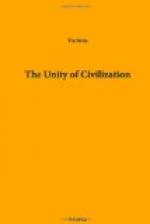It is in the southern third, or thereabouts, of the continuous Woodland, where the deciduous forest trees begin to give place to evergreens, as they themselves replaced the conifers further north, that the minutely subdivided horticulture and arboriculture begins, which characterize the Mediterranean region. To call it agriculture would be to exaggerate its scale. It is more like a northerly extension of tropical Hackbau, as the Germans call those forms of plant-raising which dispense with plough and spade, and employ only mattocks or hoes, which are little more than earth-chopping celts. You have only to watch the unhandy way in which the Greek peasant and what Homer called his ‘foot-trailing’ oxen work their Virgilian plough through the recesses of a field no bigger than a cabbage-patch, and well stocked with olive-trees besides, to realize how truly in this kind of farming the ox is in place of a house-slave to a poor man. For the house-slave could handle a zappa, the spadelike Levantine hoe, where an ox would fail to turn round, yet where food-plants could be coaxed to grow, and an olive-tree would luxuriate.
This kind of garden-cultivation indeed repeats very closely the foodquest of the Muskogean cultivators in the South-eastern States, who make up the so-called ‘civilized tribes’ and, almost alone among the Redskins, ’are all self-supporting and prosperous’.[8] In the Old World, as in the New, its distribution is closely defined by certain limits of rainfall and temperature, and most of all by the extent to which the rainfall is concentrated into a few winter months, so that a dry warm summer is assured, which Man can mitigate and even exploit if he has access to perennial water. It extended, therefore, in quite early times, and still predominates, all round the mountainous shores of the Mediterranean, from Syria by Southern Europe to Algeria and Tunis, and penetrates inland and upland into the forests till summer clouds and rainfall check it. In this region of its distribution Greek and Roman legends betray the belief that grain-cultivation came late, and superseded a staple diet of tree produce, chestnut, walnut, filbert, and acorn.[9] And when the ‘nobler grasses’ came, it was barley and red wheat that predominated, as indeed they predominate still.
But this is only one part of the distribution of the garden-culture. Far north along the Atlantic seaboard, and as far inland as the mild Atlantic climate is perceptible, the same type prevails. Its ancient limit is traced meteorologically in Tacitus’ complaints (for example) of the austerity of the lands beyond the Rhine. In this northern region grain crops pass from red to white wheat, from barley to oats, and from both to rye. The ease with which the Muskogean potato and tomato have been acclimatized, and their respective prevalence now in the Atlantic and Mediterranean sections, illustrate exactly the place which primitive hoe-culture held in the economy of the Old-World region. Early monuments of this culture, in which hoe and ox-plough are equally conspicuous, are the ‘meraviglie’ rock-carvings above Ventimiglia.[10] The fine flower of it is the Minoan civilization of the Crete and the South Aegean. Egyptian agriculture is also in great part hoe-work.




